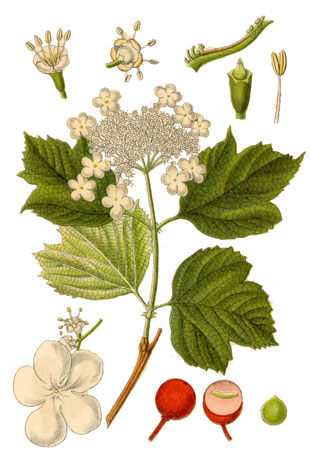Kalina ordinary – Viburnum's wealth
Shrub up to 3.4 m, families zhimolostnыh (Caprifoliaceae). The plant is found everywhere. Medical raw material is the bark of Viburnum.

Kalina ordinary – Chemical composition
Bark Viburnum It contains ether-like resin and tannins, of which are formed by hydrolysis valeric, isovaleric acid, and formic, acetic, capric, caprylic, Oil, linoleic, cerotic and palmitic acid, glikozid vyburnyn, fitosterolin, phytosterol and other chemical compounds.
Kalina ordinary – Pharmacological properties
Research on various types of laboratory animals showed, that the amount of active ingredients plant inhibits fibrinolysis by blocking plasminogen activators and partial inactivation of plasmin (fiʙrinolizina), thereby causing hemostatic effect bark plants in general. Besides, tannin substances Viburnum at intragastric introduction precipitated proteins mucus to form a dense film albumin, protects from irritation of sensitive nerve endings underlying tissues. Because of this reduces pain, due to local vasoconstriction, decreases secretion, sealed cell membranes, which leads to a reduction of inflammatory reaction.
Contained in the dosage forms of bark Viburnum valeric and isovaleric acid have antispasmodic action, reduce the excitability of the central nervous system, increase the duration of hypnotics. Prolonged use with food viburnum bark extract in animals reduced blood cholesterol and noted a significant effect of diuretic and cardiotonic, which is due to the content in the plant unsaturated fatty acids and phytosterols. These compounds are precursors of prostaglandins biogenic, involved in lipid metabolism, in the regulation of blood pressure and renal blood flow.
In addition to the hemostatic properties of herbal medicines bark viburnum enhance muscle tone of the uterus.
Kalina ordinary – Use in medicine
Galenic bark viburnum used in the treatment of various diseases primarily due to the content in the plant glycoside viburnin and tannins, astringent, hemostatic, anti-inflammatory, increases the tone uterine muscles. The liquid extract and Viburnum bark decoction is prescribed in obstetric practice with uterine bleeding, postpartum, to prevent miscarriage in the beginning abortion, for painful and heavy menstruation. As a hemostatic and anti-inflammatory drugs bark viburnum used for hemorrhoids, diseases of the gastrointestinal tract, and the therapeutic effect is already to 2-3 th day of the drug.
Infusion of bark as sedative and antihypertensive medication prescribed for neurasthenia, Hysteria, epilepsy, hypertensive disease. Fruits of Viburnum increase power of cardiac contractions, increased diuresis, improves bowel. They are appointed as a fortifying agent recovering patients, as well as skin diseases, swelling of cardiac and renal origin, for hypertension, gastric, colitis and liver diseases.
Kalina ordinary – Formulations, Dosing and Administration
Liquid extract of cranberry apply 30-40 drops before meals 2-3 times a day.
A decoction of the bark of Viburnum: 10 g (1 tablespoon) raw material is placed in an enamel bowl, Pour 200 ml (1 glass) hot boiled water, capped and heated in a boiling water bath 30 m, cooled at room temperature for 10 m, filter, wring, topped up with water to 200 ml. The prepared broth is stored in a cool place no more 2 d.
Take 1-2 tablespoons 3-4 times daily after meals as a styptic and antiseptic in the postpartum period, uterine bleeding on the basis of gynecological diseases.
The raw material stored in a dry, cool place.
Infusion of fruits Viburnum: 10g (2 tablespoons) the fruit is placed in an enamel bowl, pound, pouring slowly 200 ml (1 glass) hot boiled water, capped and heated in a boiling water bath 15 m, cooled at room temperature for 45 m, filter, wring, top up with boiled water to 200 ml. The prepared infusion stored in a cool place no more than 2 d.
Take during the day as a vitamin, restorative, diaphoretic and laxative, usually 1/3 cup 3-4 times a day.
The raw material stored in a dry, cool place.
